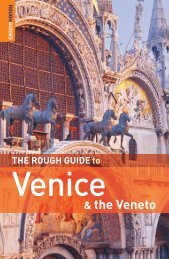Create successful ePaper yourself
Turn your PDF publications into a flip-book with our unique Google optimized e-Paper software.
52 <strong>dubrovnik</strong> neretvA CountY<br />
ano<strong>the</strong>r day by boat to squeeze into it through a 30m tunnel.<br />
Local fishermen use <strong>the</strong> grotto as a harbour.<br />
Prožura This medieval village was used by Ragusan nobles<br />
who – a bit like yourself – were looking for relaxing getaway.<br />
Perched on a hill over a Blato (an intermittent lake) and <strong>the</strong><br />
sea, Prožura has a 17th Century watch tower and three<br />
beautiful churches: <strong>the</strong> Church <strong>of</strong> <strong>the</strong> Holy Trinity, <strong>the</strong> Church<br />
<strong>of</strong> St Martin and <strong>the</strong> Church <strong>of</strong> St Rocco. The Church <strong>of</strong> <strong>the</strong><br />
Holy Trinity has characteristics similar to those <strong>of</strong> Dubrovnik’s<br />
Gothic chapels, plus a remarkable 15th Century Romanesque<br />
bronze crucifix. The church most likely was built in 1477 by <strong>the</strong><br />
Benedictines from Lokrum, who were bequea<strong>the</strong>d <strong>the</strong> estate<br />
in Prožura. The crucifix includes figured representations<br />
<strong>of</strong> St Blaise (<strong>the</strong> patron saint <strong>of</strong> Dubrovnik), St Martin (<strong>the</strong><br />
patron saint <strong>of</strong> <strong>the</strong> poor) and St Nicholas (<strong>the</strong> patron saint<br />
<strong>of</strong> sailors and fishermen). Benedictines lived and worked in<br />
a small monastery near <strong>the</strong> church. It’s partly ruined now;<br />
along with <strong>the</strong> tower, it has been adapted for reuse as a<br />
stable and storage.<br />
The Church <strong>of</strong> St Martin and village graveyard are situated<br />
on a bluff overlooking <strong>the</strong> village on one side and <strong>the</strong> island<br />
road and Pelješac Channel on <strong>the</strong> o<strong>the</strong>r. A plaque on <strong>the</strong> 14th<br />
Century porch thanks Jolanda Vecchietta, a teacher who<br />
came to <strong>the</strong> island during <strong>the</strong> Italian occupation in World War<br />
II, taught in <strong>the</strong> local school and fell in love with <strong>the</strong> island.<br />
After <strong>the</strong> war she returned to Italy but later paid for <strong>the</strong> 1998<br />
renovations to <strong>the</strong> church. St Martin’s day is celebrated on<br />
November 11 with a mass in <strong>the</strong> church.<br />
The newer Church <strong>of</strong> St Rocco is situated on ano<strong>the</strong>r small<br />
hill above <strong>the</strong> village. Costumed celebrations <strong>of</strong> St Rocco<br />
(who was believed to have saved <strong>the</strong> village from <strong>the</strong><br />
plague), take place on August 16 every year. Prožura was<br />
<strong>the</strong> birthplace <strong>of</strong> Pavao Gracić, a well known bi<strong>shop</strong> <strong>of</strong> Ston<br />
from 1635 to 1652.<br />
www.inyourpocket.com<br />
Maranovići The 18th Century Baroque house <strong>of</strong> <strong>the</strong> Peš<br />
family is in <strong>the</strong> middle <strong>of</strong> <strong>the</strong> town. The 19th Century parish<br />
church <strong>of</strong> St Anton rests on <strong>the</strong> foundations <strong>of</strong> an older church<br />
and features Gothic architectural elements.<br />
In nearby Korita, <strong>the</strong> ruined 14th Century Church <strong>of</strong> St Mary<br />
<strong>of</strong> <strong>the</strong> Hill mixes Gothic and Renaissance elements, and<br />
demonstrates features typical <strong>of</strong> <strong>the</strong> island’s churches.<br />
A roughly square plan with a deep porch extending to <strong>the</strong><br />
front, and a picturesque belfry “na preslicu” (“on a distaff,”<br />
that is, <strong>the</strong> belfry has a split where <strong>the</strong> bell hangs, <strong>the</strong> way a<br />
distaff’s end is cleft to hold wool). Some <strong>of</strong> <strong>the</strong> manor houses<br />
have Renaissance-Baroque elements. The town has its own<br />
17th Century defence tower with loopholes for firing. Korita<br />
is named for <strong>the</strong> stone troughs, common on <strong>the</strong> island, that<br />
are used to capture rainwater.<br />
Tourist information<br />
i<br />
Tourist Board Mljet, Sobra bb tel.<br />
74 60 25, fax 74 60 25, tz-mljet@<br />
du.t-com.hr, www.mljet.hr. Sobra<br />
<strong>of</strong>fice (around <strong>the</strong> side <strong>of</strong> <strong>the</strong> café at <strong>the</strong><br />
ferry pier).QDecember - March 31 Open<br />
09:00 - 14:00. Closed Sat, Sun. April -<br />
May 31 Open 08:00 - 15:00. Closed Sat, Sun.<br />
Tourist Board Goveđari (<strong>of</strong>fice actually in Polače),<br />
tel. 74 41 86, fax 74 41 86. December - March 31<br />
Open 09:00 - 14:00. Closed Sat, Sun. April - May 31<br />
Open 08:00 - 15:00. Closed Sat, Sun.<br />
Did you know...?<br />
All <strong>of</strong> <strong>the</strong> streets in Korčula’s Old Town have steps – except<br />
one, which is called “The Street <strong>of</strong> Thoughts” as you<br />
can stroll along it without worrying about tripping over!<br />
Dubrovnik In Your Pocket <strong>dubrovnik</strong>.inyourpocket.com







